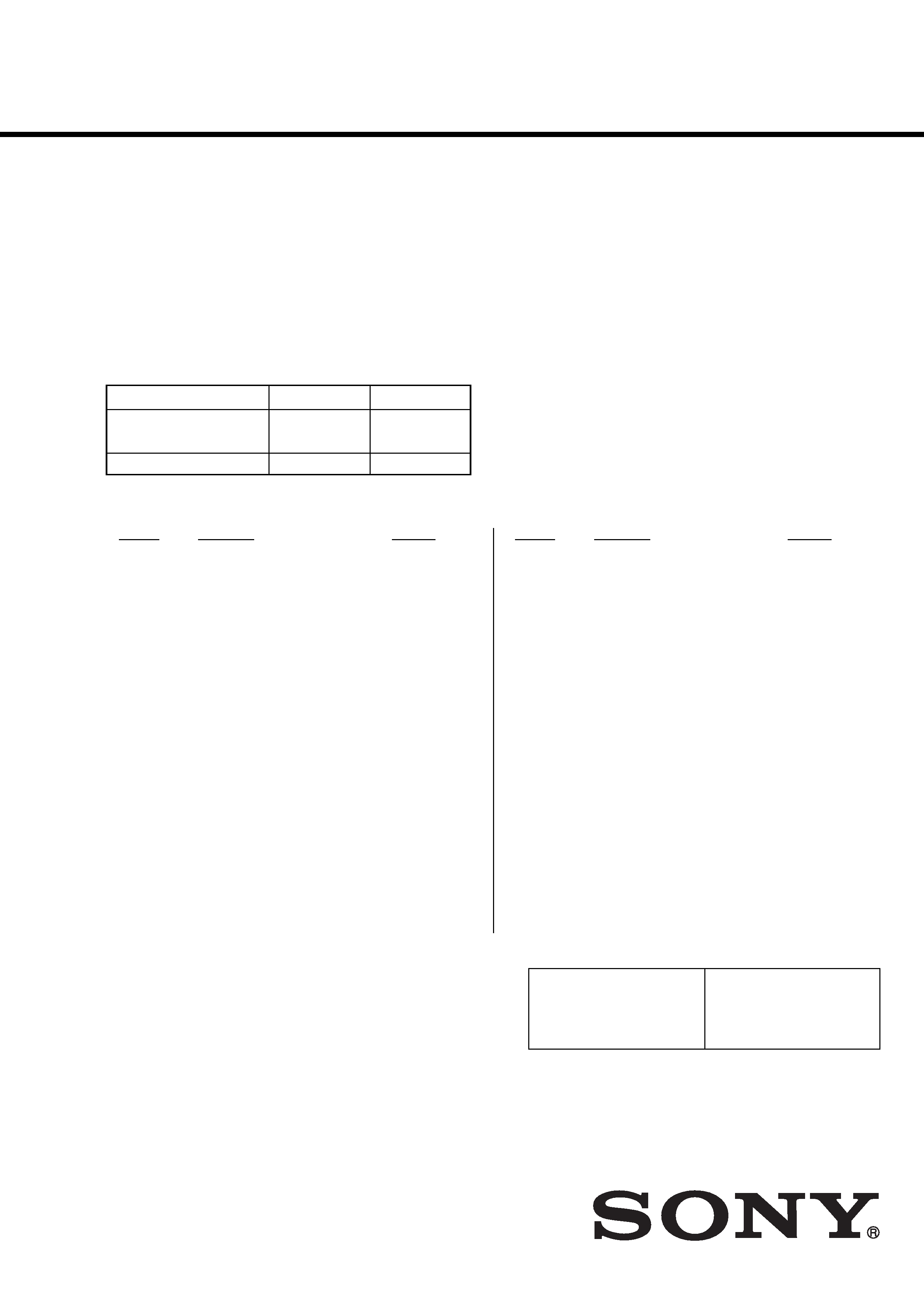
SERVICE MANUAL
Sony Corporation
Personal Audio Group
Published by Sony Engineering Corporation
US Model
CMT-HPZ9
Canadian Model
CMT-HPZ7/HPZ9
AEP Model
UK Model
CMT-HPZ7
E Model
CMT-HPZ7/HPZ9
Australian Model
CMT-HPZ9
MICRO HI-FI COMPONENT SYSTEM
9-879-567-02
2005E16-1
© 2005.05
Ver. 1.1 2005.05
CMT-HPZ7/HPZ9
· CMT-HPZ7/HPZ9 are composed of following models.
As for the service manual, it is issued for each component model,
then, please refer to them.
Part No.
Description
Remarks
PARTS LIST
·Abbreviation
CND : Canadian model
CET : East European and Russian model
MX : Mexican model
TW
: Taiwan model
E51 : Chilean and Peruvian model
AR
: Argentina model
KR
: Korean model
SP2 : Singapore model
COMPONENT MODEL NAME
CMT-HPZ7
CMT-HPZ9
COMPACT DISK DECK
HCD-HPZ7
HCD-HPZ9
RECEIVER SYSTEM
SPEAKER SYSTEM
SS-CHPZ7
SS-CHPZ9
The components identified by
mark 0 or dotted line with mark
0 are critical for safety.
Replace only with part number
specified.
Les composants identifiés par
une marque 0 sont critiques
pour la sécurité.
Ne les remplacer que par une
pièce portant le numéro spécifié.
Part No.
Description
Remarks
1-754-102-31 ANTENNA, ROOP (LW.MW)(AM)
1-754-243-11 ANTENNA (FM)
0 1-569-008-32 ADAPTOR, CONVERSION (SP2, E51)
0 1-770-019-51 ADAPTOR, CONVERSION PLUG (UK)
1-793-184-23 CONNECTOR (F TYPE ADAPTOR)(FM)
2-591-385-12 MANUAL, INSTRUCTION (ENGLISH)
(EXCEPT HPZ7 : KR, MX/HPZ9 : KR)
2-591-385-21 MANUAL, INSTRUCTION (FRENCH)(CND, AEP, SP2)
2-591-385-32 MANUAL, INSTRUCTION (SPANISH)
(AEP, MX, SP2, E51, AR)
2-591-385-41 MANUAL, INSTRUCTION (GERMAN, DUTCH)(AEP)
2-591-385-51 MANUAL, INSTRUCTION (ITALIAN, PORTUGUESE)(AEP)
2-591-385-61 MANUAL, INSTRUCTION (SWEDISH, DANISH, FINNISH)
(CET)
2-591-385-71 MANUAL, INSTRUCTION (POLISH, CZECH, HUNGARIAN)
(CET)
2-591-385-81 MANUAL, INSTRUCTION (GREEK, RUSSIAN)(CET)
2-591-385-91 MANUAL, INSTRUCTION (TRADITIONAL CHINESE)
(TW,SP2)
2-591-386-11 MANUAL, INSTRUCTION (KOREAN)(KR)
2-591-387-11 MANUAL, INSTRUCTION (Sonic Stage Ver.2.3)
(ENGLISH)(EXCEPT HPZ7: KR, MX/HPZ9:KR)
2-591-387-21 MANUAL, INSTRUCTION (Sonic Stage Ver.2.3)
(FRENCH)(CND, AEP, SP2)
2-591-387-31 MANUAL, INSTRUCTION (Sonic Stage Ver.2.3)
(SPANISH)(AEP, MX, SP2, E51, AR)
2-591-387-41 MANUAL, INSTRUCTION (Sonic Stage Ver.2.3)
(GERMAN, DUTCH)(AEP)
2-591-387-51 MANUAL, INSTRUCTION (Sonic Stage Ver.2.3)
(ITALIAN, PORTUGUESE)(AEP)
2-591-387-61 MANUAL, INSTRUCTION (Sonic Stage Ver.2.3)
(SWEDISH, DANISH, FINNISH)(CET)
2-591-387-71 MANUAL, INSTRUCTION (Sonic Stage Ver.2.3)
(POLISH, CZECH, HUNGARIAN)(CET)
2-591-387-81 MANUAL, INSTRUCTION (Sonic Stage Ver.2.3)
(GREEK, RUSSIAN)(CET)
2-591-388-11 MANUAL, INSTRUCTION (Sonic Stage Ver.2.3)
(TRADITIONAL CHINESE)(TW,SP2)
2-591-388-21 MANUAL, INSTRUCTION (Sonic Stage Ver.2.3)
(KOREAN)(KR)
7-685-103-19 SCREW +P 2X5 TYPE2 NON-SLIT (FOR SPEAKER)
A-1108-433-A COMMANDER, STANDARD (RM-SC50)
(Including Battery Cover)
X-2050-858-1 CD-ROM (APPLICATION) ASSY (SS2.3)

CMT-HPZ7/HPZ9
REVISION HISTORY
Clicking the version allows you to jump to the revised page.
Also, clicking the version at the upper right on the revised page allows you to jump to the next revised
page.
Ver.
Date
Description of Revision
1.0
2005.03
New
1.1
2005.05
Addition of E model for CMT-HPZ7/HPZ9
Addition of Australian model for CMT-HPZ9

SERVICE MANUAL
Sony Corporation
Personal Audio Group
Published by Sony Engineering Corporation
US Model
HCD-HPZ9
Canadian Model
HCD-HPZ7/HPZ9
AEP Model
UK Model
HCD-HPZ7
E Model
HCD-HPZ7/HPZ9
Australian Model
HCD-HPZ9
MICRO HI-FI COMPONENT SYSTEM
9-879-566-05
2005I16-1
© 2005.09
Ver. 1.4 2005.09
SPECIFICATIONS
HCD-HPZ7/HPZ9
HCD-HPZ7/HPZ9 are the Amplifier, CD player, Tape
Deck and Tuner section in CMT-HPZ7/HPZ9.
-- Continued on next page --
Former Type Models
New Type Models
Model Name Using Similar Mechanism
NEW
NEW
CD
CD Mechanism Type
CDM82C-F1BD83
CDM82C-K6BD83
Section
Base Unit Name
BU-F1BD83
BU-K6BD83
Optical Pick-up Name
KSM-215DCP
KSM-213DCP/C2NP
TAPE
Model Name Using Similar Mechanism
NEW
NEW
Section
Tape Transport Mechanism Type
CMAL5Z225A
CMAL5Z225A
Photo : HCD-HPZ7
Amplifier section
For the United States model
AUDIO POWER SPECIFICATIONS
HCD-HPZ9
POWER OUTPUT AND TOTAL HARMONIC
DISTORTION:
With 6-ohm loads, both channels driven, from
120 10,000 Hz: rated 85 watts per channel
minimum RMS power, with no more than 10%
total harmonic distortion from 250 milliwatts to
rated output.
HCD-HPZ7
POWER OUTPUT AND TOTAL HARMONIC
DISTORTION:
With 6-ohm loads, both channels driven, from
120 10,000 Hz: rated 50 watts per channel
minimum RMS power, with no more than 10%
total harmonic distortion from 250 milliwatts to
rated output.
HCD-HPZ9
North American model:
Continuous RMS power output (reference):
85 + 85 W
(6 ohms at 1 kHz, 10%
THD)
Other models:
The following measured at AC 240 V, AC 220 V or AC
120 V
DIN power output (rated): 53 + 53 W
(6 ohms at 1 kHz, DIN)
Continuous RMS power output (reference):
70 + 70 W
(6 ohms at 1 kHz, 10%
THD)
HCD-HPZ7
North American model:
Continuous RMS power output (reference):
50 + 50 W
(6 ohms at 1 kHz, 10%
THD)
European model:
DIN power output (rated): 50 + 50 W (6 ohms at
1kHz, DIN)
Continuous RMS power output (reference):
60 + 60 W (6 ohms at
1kHz, 10% THD)
Music power output (reference):
100 + 100 W (6 ohms at
1kHz, 10% THD)
Other models:
The following measured at AC 220 240 V, 50/60 Hz
DIN power output (rated): 45 + 45 W
(6 ohms at 1 kHz, DIN)
Continuous RMS power output (reference):
50 + 50 W
(6 ohms at 1 kHz, 10%
THD)
Inputs
ANALOG IN (stereo mini jack):
Sensitivity 250 mV,
impedance 47 kilohms
Outputs
CD DIGITAL OUT:
Optical Wavelength:
660 nm
PHONES (stereo mini jack):
accepts headphones with
an impedance of 8 ohms or
more
SPEAKER:
accepts impedance of 6 to
16 ohms
US and foreign patents licensed from
Dolby Laboratories.

2
HCD-HPZ7/HPZ9
SAFETY-RELATED COMPONENT WARNING!!
COMPONENTS IDENTIFIED BY MARK 0 OR DOTTED LINE
WITH MARK 0 ON THE SCHEMATIC DIAGRAMS AND IN
THE PARTS LIST ARE CRITICAL TO SAFE OPERATION.
REPLACE THESE COMPONENTS WITH SONY PARTS WHOSE
PART NUMBERS APPEAR AS SHOWN IN THIS MANUAL OR
IN SUPPLEMENTS PUBLISHED BY SONY.
ATTENTION AU COMPOSANT AYANT RAPPORT
À LA SÉCURITÉ!
LES COMPOSANTS IDENTIFIÉS PAR UNE MARQUE 0 SUR
LES DIAGRAMMES SCHÉMATIQUES ET LA LISTE DES
PIÈCES
SONT
CRITIQUES
POUR
LA
SÉCURITÉ
DE
FONCTIONNEMENT. NE REMPLACER CES COM- POSANTS
QUE PAR DES PIÈCES SONY DONT LES NUMÉROS SONT
DONNÉS DANS CE MANUEL OU DANS LES SUPPLÉMENTS
PUBLIÉS PAR SONY.
CD player section
System
Compact disc and digital
audio system
Laser Diode Properties
Emission duration:
continuous
Laser Output*:
Less than 44.6
µW
*This output is the value measurement at a distance of
200 mm from the objective lens surface on the
Optical Pick-up Block with 7 mm aperture.
Frequency response
20 Hz 20 kHz (
±0.5 dB)
Wavelength
780 790 nm
Tape deck section
Recording system
4-track 2-channel stereo
Frequency response
50 13,000 Hz (
±3 dB),
using Sony TYPE I
cassettes
Tuner section
FM stereo, FM/AM superheterodyne tuner
FM tuner section
Tuning range
87.5 108.0 MHz
Antenna
FM lead antenna
Antenna terminals
75 ohms unbalanced
Intermediate frequency
10.7 MHz
AM tuner section
Tuning range
Pan-American model:
530 1,710 kHz
(with the tuning interval
set at 10 kHz)
531 1,710 kHz
(with the tuning interval
set at 9 kHz)
European model:
531 1,602 kHz
(with the tuning interval
set at 9 kHz)
Other models:
530 1,710 kHz
(with the tuning interval
set at 10 kHz)
531 1,602 kHz
(with the tuning interval
set at 9 kHz)
Antenna
AM loop antenna
Antenna terminals
External antenna terminal
Intermediate frequency
450 kHz
General
Power requirements
North American model:
120 V AC, 60 Hz
European model:
230 V AC, 50/60 Hz
Other models:
120 V, 220 V or 230
240 V AC, 50/60 Hz
Adjustable with voltage
selector
Power consumption
HPZ9
North American model:
145 W
Other models:
125 W
HPZ7
North American model:
85 W
European model:
95 W
0.25 W (in Power Saving
Mode)
Other models:
90 W
Dimensions (w/h/d) (excl. speakers)
Approx. 198
× 275 ×
341 mm
Mass (excl. speakers)
Amplifier/Tuner/Tape/CD section:
HPZ9 :
7.7 kg
HPZ7 :
7.3 kg
Design and specifications are subject to change
without notice.

3
HCD-HPZ7/HPZ9
The laser diode in the optical pick-up block may suffer electrostatic
break-down because of the potential difference generated by the
charged electrostatic load, etc. on clothing and the human body.
During repair, pay attention to electrostatic break-down and also
use the procedure in the printed matter which is included in the
repair parts.
The flexible board is easily damaged and should be handled with
care.
NOTES ON LASER DIODE EMISSION CHECK
The laser beam on this model is concentrated so as to be focused on
the disc reflective surface by the objective lens in the optical pick-
up block. Therefore, when checking the laser diode emission,
observe from more than 30 cm away from the objective lens.
LASER DIODE AND FOCUS SEARCH OPERATION
CHECK
Carry out the "S curve check" in "CD section adjustment" and check
that the S curve waveforms is output three times.
NOTES ON HANDLING THE OPTICAL PICK-UP
BLOCK OR BASE UNIT
Notes on chip component replacement
· Never reuse a disconnected chip component.
· Notice that the minus side of a tantalum capacitor may be
damaged by heat.
Flexible Circuit Board Repairing
· Keep the temperature of the soldering iron around 270 °C
during repairing.
· Do not touch the soldering iron on the same conductor of the
circuit board (within 3 times).
· Be careful not to apply force on the conductor when soldering
or unsoldering.
CAUTION
Use of controls or adjustments or performance of procedures
other than those specified herein may result in hazardous radiation
exposure.
UNLEADED SOLDER
Boards requiring use of unleaded solder are printed with the lead-
free mark (LF) indicating the solder contains no lead.
(Caution: Some printed circuit boards may not come printed with
the lead free mark due to their particular size)
: LEAD FREE MARK
Unleaded solder has the following characteristics.
· Unleaded solder melts at a temperature about 40 °C higher
than ordinary solder.
Ordinary soldering irons can be used but the iron tip has to be
applied to the solder joint for a slightly longer time.
Soldering irons using a temperature regulator should be set to
about 350
°C.
Caution: The printed pattern (copper foil) may peel away if
the heated tip is applied for too long, so be careful!
· Strong viscosity
Unleaded solder is more viscou-s (sticky, less prone to flow)
than ordinary solder so use caution not to let solder bridges
occur such as on IC pins, etc.
· Usable with ordinary solder
It is best to use only unleaded solder but unleaded solder may
also be added to ordinary solder.
Laser component in this product is capable of emitting radiation
exceeding the limit for Class 1.
This appliance is classified as a CLASS 1 LASER product.
The CLASS 1 LASER PRODUCT MARKING is located on the
exterior.
SAFETY CHECK-OUT
After correcting the original service problem, perform the following
safety check before releasing the set to the customer:
Check the antenna terminals, metal trim, "metallized" knobs, screws,
and all other exposed metal parts for AC leakage.
Check leakage as described below.
LEAKAGE TEST
The AC leakage from any exposed metal part to earth ground and
from all exposed metal parts to any exposed metal part having a
return to chassis, must not exceed 0.5 mA (500 microamperes.).
Leakage current can be measured by any one of three methods.
1. A commercial leakage tester, such as the Simpson 229 or RCA
WT-540A. Follow the manufacturers' instructions to use these
instruments.
2. A battery-operated AC milliammeter. The Data Precision 245
digital multimeter is suitable for this job.
3. Measuring the voltage drop across a resistor by means of a
VOM or battery-operated AC voltmeter. The "limit" indication
is 0.75 V, so analog meters must have an accurate low-voltage
scale. The Simpson 250 and Sanwa SH-63Trd are examples
of a passive VOM that is suitable. Nearly all battery operated
digital multimeters that have a 2 V AC range are suitable. (See
Fig. A)
1.5 k
0.15
µF
AC
voltmeter
(0.75 V)
To Exposed Metal
Parts on Set
Earth Ground
Fig. A.
Using an AC voltmeter to check AC leakage.
